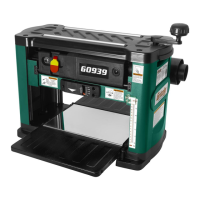-22-
Model G0939/G0940 (Mfd. Since 12/20)
Workpiece
Inspection
Wood Types
Some workpieces are not safe to use or may
require modification before they are. Before cut-
ting, inspect all workpieces for the following:
• Material Type: This machine is only intend-
ed for workpieces of natural wood fiber.
Attempting to use workpieces of any other
material that may break apart during opera-
tion could lead to serious personal injury and
property damage.
• Foreign Objects: Inspect lumber for defects
and foreign objects (nails, staples, embedded
gravel, etc,). If you have any questions about
the quality of your lumber, DO NOT use it.
Remember, wood stacked on a concrete floor
can have small pieces of stone or concrete
pressed into the surface.
• Large/Loose Knots: Loose knots can
become dislodged during operation. Large
knots can cause kickback and machine dam-
age. Always use workpieces that do not have
large/loose knots.
• Wet or "Green" Stock: Avoid using wood
with a high water content. Wood with more
than 20% moisture content or wood exposed
to excessive moisture (such as rain or snow),
will plane poorly and cause excessive wear to
the machine. Excess moisture can also has-
ten rust and corrosion of the machine and/or
individual components.
• Excessive Warping: Workpieces with
excessive cupping, bowing, or twisting are
dangerous to plane because they are unsta-
ble and often unpredictable when being
planed. DO NOT use workpieces with these
characteristics!
• Minor Cupping: Always true a cupped
workpiece with a jointer prior to planing.
Workpieces with slight cupping can be safely
supported if the cupped side is facing the
table. Avoid planing a workpiece bowed
side-down, which can cause rocking during
planing and potential kickback.
The species of wood, as well as its condition,
greatly affects the depth of cut the planer can
effectively take with each pass.
The chart in the figure below shows the Janka
Hardness Rating for a number of commonly
used species. The higher the number, the harder
the workpiece, and the less material should be
removed in any one pass for good results.
Note: The Janka Hardness Rating is expressed in
pounds of force required to embed a 0.444" steel
ball into the surface of the wood to a depth equal
to half the ball's diameter.
Species
Janka
Hardness
Ebony 3220
Red Mahogany 2697
Rosewood 1780
Red Pine 1630
Sugar Maple 1450
White Oak 1360
White Ash 1320
American Beech 1300
Red Oak 1290
Black Walnut 1010
Teak 1000
Black Cherry 950
Cedar 900
Sycamore 770
Douglas Fir 660
Chestnut 540
Hemlock 500
White Pine 420
Basswood 410
Eastern White Pine 380
Balsa 100
Figure 14. Janka Hardness Rating for some
common wood species.

